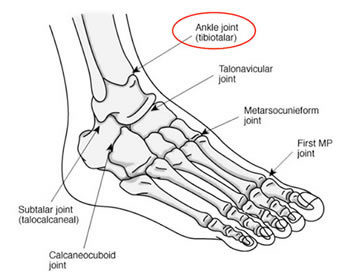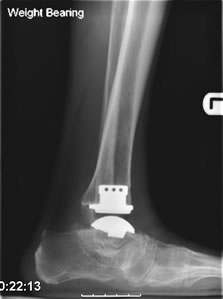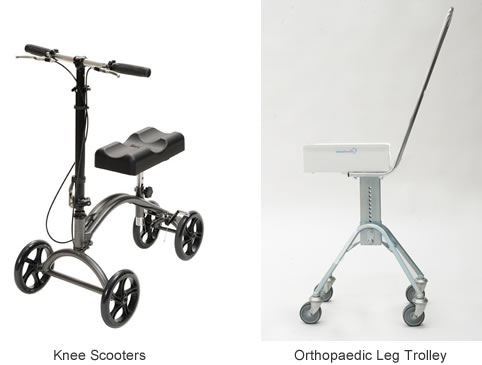Ankle Replacement
This operation replaces the degenerate joint with metal and polyethylene. It is similar to a knee replacement. The surfaces of the joint are replaced with specially designed metal replacements, which articulate with a very strong plastic insert (ultra high density polyethylene). Once healed, the joint will be mobile and ideally pain free, although some discomfort should be expected.
Following surgery, you should be able to walk much more normally, with minimal pain and often with more movement than before.
Although joint replacements in the hip and knee have been studied for decades now, Ankle replacements are relatively new and do not have such long term information on outcome. Currently we have results on the survival (success) for 10-12 years with approximately 90% of operations remaining a success – this is similar to the success rates for knee replacement.


Prior to surgery
It is important to make sure that the leg and skin are as healthy as possible.
- The surgery cannot go ahead if there are any grazes, insect bites or infections. Please notify Fortius if you have any of these.
- If you suffer from swollen ankles, use a compression sock or keep the legs elevated as much as possible for 1-2 days before surgery.
- No food, drink or smoking 6 hours before surgery (clear water can be taken up to 2 hours before)
- Please bring any xrays and scans of the ankle with you.
You will need to use crutches or a frame for the first 2-4 weeks after surgery. Please see a physiotherapist prior to surgery to practice walking with crutches/frame and one leg "non-weightbearing".
There are some aids that can be hired to help whilst using crutches.

Please see www.wheelfreedom.com for details.
Admission
You will need to go to hospital at least 2 hours prior to the surgery, to prepare for surgery and for your stay at hospital. Expect to be an inpatient for 3-4 days. Your length of stay in hospital will depend on your ability to get up on crutches or a frame, so time spent in training prior to surgery will be valuable.
Surgery
The surgery is usually performed under general anaesthetic with a "popliteal block" – this is the same as an epidural but placed at the knee. It will make your leg numb below the knee for 1-3 days and provides excellent pain relief.
The surgery is performed through a 15cm incision over the front of the ankle. The arthritic joint surfaces are excised (cut out) and the tibia and talus shaped to receive the new joint. The implants are locked in place and are uncemented – i.e. bone grows into them. The operation takes approximately 2 hours.
After surgery, your leg will be immobilised in a backslab (half plaster) for 2 weeks. Elevation of the foot (above the pelvis) for the first 10 days is vitally important to prevent infection. Naturally, small periods of walking and standing are necessary, but no weight must be taken through this leg for 2 weeks.
After 2 weeks the backslab will be removed and the stitches taken out, here in clinic. If all is well, you can begin weight bearing at that stage. Physiotherapy to regain the ankle motion, can start at this stage.
You will be reviewed again at 6 weeks & 3 months following surgery, with x-rays.
"I would like to thank you for the wonderful job done... a huge success. I walk my dogs over rough ground, climb up fairly steep slopes with little or no swelling. In short I am thrilled with the operation!".
LW
Risks of surgery
Swelling
Initially the foot will be very swollen and needs elevating. The swelling will disperse over the following weeks & months but will still be apparent at 6-9 months.
Infection
This is the biggest risk with this type of surgery. Smoking increases dramatically. You will be given intravenous antibiotics to prevent against it. The best way to reduce your chances of acquiring an infection is to keep the foot elevated for 10 days. If there is an infection, it is usually mild and resolves with a course of antibiotics. Rarely, it can be severe requiring further surgery.
Nerve Damage
Alongside the incision are three nerves – the deep & superficial peroneal and the saphenous nerves. They supply sensation to the side and the top of the foot and toes. They may become damaged during the surgery and this will leave a patch of numbness, either at the side of the foot or over the top of the foot and toes. This is usually temporary but may be permanent. There is approximately a 10-15% of this happening.
Wear of the replacement
The metal / polyethylene joint has an unknown lifespan at present. When it fails, it is either due to infection or wearing away of the polyethylene. This usually takes several years; we do not have an average longevity yet. Once the joint wears out, further surgery is normally required to fuse the joint together. Hopefully, this never becomes necessary, but a 10-15 year period is a reasonable estimate for the survival of the ankle joint.
Dislocation
This is rare.
Recovery from surgery
This is significant surgery and patience will be required in a aiding a gradual recovery process. Strict elevation for many days after the procedure is necessary to control swelling and improve wound healing.
- Expect swelling for over one year! A long compression sock can help with this.
- Expect discomfort for 3-4 months.
- Driving should be possible after 4-6 weeks.
- It will take 4-6 months for you to be able to walk for over ½ hour.
Activity and time off work
- In general, 4 weeks off work is required for sedentary posts
- 8 weeks for standing or walking posts
- If you are a farmer, gardener or involved in similar active pursuits it may be 12 weeks before you can begin to put strain on the joint.
Follow up
- 2 weeks for removal of sutures & plaster
- 6 weeks in Mr Rosenfeld's clinic: AP & Lateral X-rays
- 3 Months: WB X-ray
- 6 months: WB X-ray and Annual X-rays thereafter.